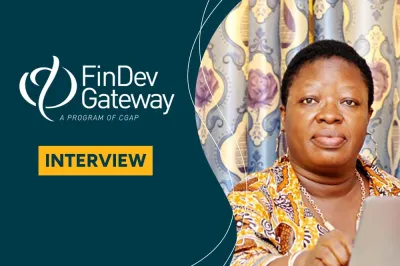Gateway Guide to Digital Transformation of Microfinance Institutions

This Gateway Guide was originally published in May 2019. It has been updated to include additional resources on digital transformation.
If you are an executive of a microfinance institution (MFI), more than likely you have thought about taking the digital transformation route for your organization. Research tells you it’s inevitable. Industry pundits warn you that you must “adapt or perish!” Conferences all over the world offer to help you start on this path, with headlines of “demystifying digital,” digitizing savings groups, and ensuring an “inclusive digital future.” To top it all off, according to McKinsey’s report on “The Fight for the Customer,” you could lose 20 to 60 percent of your profits by 2025 if you don’t get on board with digitalization.
And yet, you may also be holding back because you face a barrage of difficult questions such as: Where should you start? Is your organization ready to undergo transformation? What are the drawbacks or risks to consider before you dive in?
To help you as you consider all these questions, we scanned the industry to bring you the latest research and practical lessons on digital transformation for microfinance institutions. Here we share our main takeaways, along with the publications and resources we found that can help you to dig in further.
- Not all organizations are ready to digitize at the same speed. The Digital Maturity Matrix presented in this digital transformation guide by Accion can help FSPs select which processes to prioritize based on their current and desired level of digital maturity. The guide distills emerging best practices into a framework to deepen FSPs’ understanding of digital lending, identify their own digital lending objectives and maturity, and take the first steps towards implementation.
- There are many approaches to digital transformation. And there is a growing body of case studies and toolkits which can help you explore what would work best for your organization. In Bangladesh, a UNCDF study focusing on the microfinance sector explores technology options and identifies key pillars for digital transformation. In another study, UNCDF zooms in on a microfinance institution in Senegal highlighting key benefits that result from small operational improvements.
In Africa, IFC and Mastercard Foundation recently concluded a seven-year joint initiative, the Partnership for Financial Inclusion, which aimed to expand microfinance and advance digital financial services (DFS) in Sub-Saharan Africa and produced a number of useful publications. The four-year MFI longitudinal study, Turning MFI Digital Strategies Into Reality, identifies successful strategic approaches and lessons learned from the experiences of nine MFIs deploying digital financial services. Changing Change Management: Adapting Internal and External Culture in Times of Digital Transformation provides guidance on the cultural and interpersonal aspects of this process for MFIs. And their concluding report, Digital Access: The Future of Financial Inclusion in Africa, offers case studies, market overviews, industry opinion and research focused on multiple aspects of digital financial services, including strategy, selecting the right technology, agent networks, customer acquisition and data analytics.
Choosing the right model can be daunting, so UNCDF, Mastercard Foundation and PHB Development developed a suite of six toolkits on How to Succeed in Your Digital Journey, each focused on a different business model. These toolkits aim to support financial service providers to integrate digital channels into their service delivery approaches.
- Partnerships between financial institutions and fintechs can play an important role in enabling financial inclusion. A report from the Center for Financial Inclusion at Accion highlights 14 partnerships in Africa that exemplify best-case scenarios and good practice. The report shows how financial institutions are using partnerships to offer more choices to customers and for expanding outreach to lower income people. Partnerships also drive institutional-level innovation and help incumbent institutions to remain competitive.
- Finding the right balance between technology and the human touch is key for acquiring and retaining customers. Depending on the market, MFI customers may not be ready for a fully digital financial product or service due to lack of trust in providers or discomfort using technology. When MFIs think about digitizing, the key is finding the right balance between technology and human touch to accommodate their technology-shy customers. Accion's paper, “The Tech Touch Balance,” explores the combination of digital solutions with human touch through eight case studies from Kenya, India, Colombia, South Africa, United States, Mexico and Peru.
- Regulators need to keep pace with DFS to enable financial inclusion and mitigate risks. Successful collaboration between MFIs, digital financial service providers and fintechs can accelerate financial inclusion. A recent Alliance for Financial Inclusion report provides recommendations and policy options to optimize the synergies between digital finance and microfinance to facilitate the digital transformation of microfinance services and deepen financial inclusion in Africa.
- To leverage fintech successfully, MFIs will need strategic guidance from the board and management, and sufficient financial and human resources. Triple Jump’s survey of African MFIs provides insights into how MFIs are navigating the fintech revolution and what they see to be key challenges and opportunities of Fintech for microfinance institutions.
- Financial institutions should seriously consider incorporating Artificial Intelligence as part of their long-term strategy. A study by FIBR, BFA, and Mastercard Foundation explains why financial institutions should embrace artificial intelligence to reduce cost, manage risks, and gain a competitive edge.
Tomorrow belongs to those who understand the change that is happening and can take advantage of available technologies.
FinDev Interviews with Experts
With digital transformation at the forefront of everyone's mind these days, it's come up a lot in our conversations with financial inclusion experts as well. Check out these interviews to gain insights and advice from industry leaders as they grapple with these issues.
Does Digital Transformation Mean Turning Your Employees Into Robots? Grzegorz Galusek, Executive Director of the Microfinance Centre (MFC) shares his thoughts on incremental digitization, the need to re-skill for MFI staff, and effective change management practices for MFIs on the path of digital transformation.
Don’t Let Digitization Create More Inefficiencies Faisal Abdul Wahab, managing partner at IT consulting firm PCES, says “Most MFIs, due to their resource constraints (especially in IT), tend to go for off-the-shelf solutions which are not tailored to their specific needs. Therefore, they end up with unproductive or inefficient processes, or simply lose their technological edge due to the difficult adaptation period and resulting user reluctance.” He discusses how his company helps MFIs avoid that pitfall and find smart ways to go digital.
Are Soft Skills Still Relevant As Microfinance Moves Into the Digital Age? “In a constantly changing world in which many hard skills are being overtaken by advancing technology, soft skills are the critical differentiating factor for future success,” argues Peter Surek, European Microfinance Network (EMN) Board Member, in this wide-ranging interview on human resource challenges and disruptive technology.
Webinar Recordings
Laying the Groundwork for Digital Transformation
Making Change Happen: Lessons From Microfinance Institutions
The Role of Technology in Digital Transformation



Last century everybody jumped of the bandwagon playing an appealing and dangerous leitmotif "a loan for everybody" and we witnessed the consequences: financial implosion at micro and macro level. Currently there is the risk the history will repeat it self, unless, the providers (finance and digital) will offer products that are sustainable for them, affordable for the users and market transparent.
To benefit of the advanced technologies, people must have a job or having access to opportunities in a way that to profit from the technologies, in dignity and freedom. It has been estimated that only 15% of the financial flow is going to the real economy. Doing something to increase above percentage is the genuine meaning of inclusive growth.
Three years ago we wrote down: "Most opportunely, Technologists JAMPED ON THE BAND-WAGON playing an unreliable “everybody deserves a connection”, which may remind us what happened some time forty years ago when everybody agreed on an unrealistic message telling everybody is entitled for a loan. We know the unfortunate impact and, at last, since end 2015 in a span of few months, the financial establishment phased out microfinance (https://www.cgap.org/research/publication/new-funder-guidelines-market-… and replaced it with financial inclusion( http://www.bis.org)".
Leave a comment